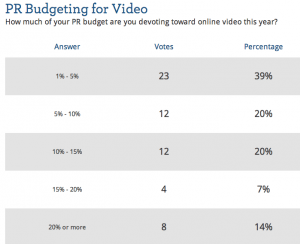We've all heard the growing stats about YouTube: more than 800 million unique viewers watch a total of four billion hours of video on the platform each month.
We also all know that your brand's videos likely won't be seen by millions of people without an integrated approach (using email lists, Facebook, a blog, media outreach, etc.). Still, the writing is on the wall—the ability to create and embed video into brand communications is a necessary skill.
With that in mind, we asked our online audience, "How much of your PR budget are you devoting toward online video this year?" Of the 60 respondents, 20% are spending less than 10% of their budget on video. Perhaps we chalk it up to small sample size, but that number is still telling.
So why is it that PR budgets are allocating, on average, so few dollars to video? For one, video creation is becoming more accessible and user-friendly. Projects that may have once been outsourced to video production agencies can now be done in-house, possibly even by an intern. Whereas videos may have once required staggering production costs, they can now be completed with cheap hand-held cameras and be edited on basic software. Of course, brands that opt for higher production values do standout (think Dollar Shave Club).
When Twitter acquired Vine, a mobile service that lets users capture and share short looping videos and embed them in their tweets, the barriers to video entry became even less—shooting and sharing was possible with just a smartphone. Brands like Urban Outfitters, Gap, Lucky Magazine and PBS were experimenting with the platform within hours.
So, just like most organizations have done in the last five years from a business standpoint, brands are actually doing more video, but with less of a budget.
Dane Frederiksen, principal at Digital Accomplice, a company that develops brand content, has some tips on how to ensure you’re not entering the video forest blind:
1) Figure the costs of not. Ask yourself, what might video do to help me get my message out and what’s the cost of not doing anything? This helps give a framework for how valuable video can be as a part of your strategy.
2) Humans are visual animals. People like to see how a person they do business with looks like, and see their expressions when describing how a product works. It builds familiarity and trust.
3) Video boosts sales. Video product demos can boost sales by 20%-40%. Zappos, the online shoe retailer, is creating another 50,000 product demos for this reason.
4) Video enables optimal SEO. Produce video content regularly and you will float toward the top of organic search results.
5) Video has legs. Fresh content is critical, but in the right situation a video could be used for months or even years. Smart organizations plan a one-day shoot and stockpile evergreen content to be used for several videos and distributed over time.
Follow Bill Miltenberg: @bmiltenberg

